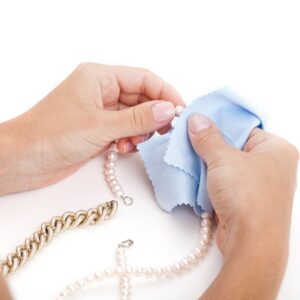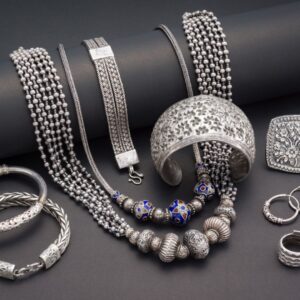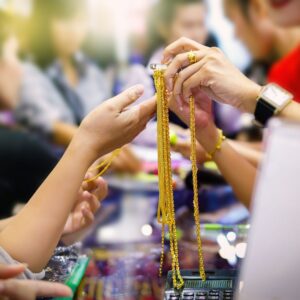Jewelry is not just a beautiful accessory; it’s an investment, a gift, or sometimes a family heirloom passed down through generations. But with the growing popularity of gold, silver, and other precious metals in jewelry, counterfeit products have become a serious concern. The Bureau of Indian Standards (BIS) has introduced a hallmarking system to ensure that consumers get the quality they pay for. In this blog, we’ll explore how to identify BIS-hallmarked jewelry, its significance, and how you can avoid falling for counterfeit jewelry. Additionally, we’ll also discuss how jewelry software can help jewelers streamline their hallmarking processes and ensure compliance with BIS standards, offering a more reliable and efficient way to manage inventory and certification.
What is BIS Hallmarking?
BIS hallmarking is a certification provided by the Bureau of Indian Standards (BIS) for gold, silver, and platinum jewelry. The hallmark assures that the jewelry has met the required standards for purity and weight. The hallmark is an official mark or stamp that guarantees the metal’s quality and compliance with international standards.
The BIS hallmark system in India came into existence to protect the interests of consumers. It provides a mechanism for ensuring that the jewelry they purchase is genuine and of the declared purity. This hallmark helps consumers identify the quality of the metal used, ensuring that they are getting value for their money.
The Importance of BIS Hallmarking in Jewelry
The presence of the BIS hallmark on jewelry serves several purposes. Firstly, it assures customers of the purity of the metal used in their jewelry. The hallmark indicates that the jewelry has been tested for purity and conforms to the standards laid down by BIS.
Secondly, hallmarking provides legal protection for consumers. In case of any dispute, consumers can use the hallmark as proof that the jewelry they bought is authentic and meets the required purity standards. It ensures transparency in transactions and protects buyers from being deceived by counterfeit jewelry.
Lastly, BIS hallmarking promotes ethical practices in the jewelry industry. It helps in preventing the sale of substandard and adulterated precious metals, thereby boosting consumer confidence in the market.
The Components of a BIS Hallmark
The BIS hallmark on jewelry is not just a random stamp. It consists of various components that help consumers verify the authenticity of the product. The hallmark typically contains the following elements:
1. BIS Logo
The BIS logo is the primary symbol that identifies the product as being certified by the Bureau of Indian Standards. It is an official mark that represents the credibility of the certification process. The logo consists of a stylized depiction of a lion, symbolizing strength and reliability, and the letters “BIS.”
2. Purity Mark
The purity mark is one of the most important elements of the BIS hallmark. This mark indicates the percentage of the precious metal (gold, silver, or platinum) used in the jewelry. For example, in gold jewelry, the purity mark could read “22K” or “24K,” signifying the number of karats and the metal’s purity. Gold jewelry is typically available in 22-karat, 24-karat, or 18-karat variants. Higher karat numbers denote purer gold.
3. Assay Center’s Mark
The assay center’s mark indicates that the jewelry has been tested and certified by a recognized laboratory. These centers are responsible for testing the purity of precious metals and issuing the appropriate certification. The assay center’s mark is usually a small symbol or code that represents the laboratory that conducted the test.
4. Hallmarking Year
The hallmarking year indicates the year in which the jewelry was tested and certified. This information can be crucial in identifying when the certification was issued and provides transparency regarding the jewelry’s authenticity.
5. Jeweler’s Identification Mark
This is the jeweler’s unique stamp or code that indicates which jewelry manufacturer or retailer has sold the product. It allows customers to trace the product back to the jeweler for any future references or inquiries.
How to Identify BIS-Hallmarked Jewelry
Identifying BIS-hallmarked jewelry may seem challenging at first, but with the right knowledge, you can easily verify whether the jewelry you’re purchasing is genuine. Here’s how to identify BIS-hallmarked jewelry:
1. Look for the BIS Logo
The first thing you should do is check for the BIS logo. The hallmark should have the official BIS logo, which consists of the lion symbol and the letters “BIS.” This is a guarantee that the product has been certified by the Bureau of Indian Standards. Without this logo, the jewelry cannot be considered BIS-certified.
2. Check the Purity Mark
The purity of the metal is the most critical factor in identifying genuine BIS-hallmarked jewelry. The purity mark will indicate the percentage of precious metal used in the jewelry. For example, “22K” means 22 out of 24 parts of the jewelry are pure gold. The purity mark should be clearly visible and easy to read.
3. Examine the Assay Center’s Mark
Each BIS-hallmarked piece of jewelry will also feature the mark of the assay center where the product was tested for purity. The assay center is a laboratory that is recognized by BIS and authorized to certify the purity of precious metals. Look for the symbol or code representing the specific assay center.
4. Inspect the Hallmarking Year
The hallmarking year is essential for determining when the jewelry was tested and certified. Check for a number or symbol indicating the year of certification. This ensures that the jewelry has been recently tested and meets the required standards for purity.
5. Check for the Jeweler’s Identification Mark
A BIS-hallmarked piece of jewelry should also have a jeweler’s identification mark, usually stamped on the jewelry itself. This mark identifies the manufacturer or retailer that sold the jewelry. If the mark is missing, it could indicate that the jewelry was not tested or certified by the appropriate standards.
6. Pay Attention to the Font and Design
Counterfeit jewelry often displays hallmarks that appear blurry or poorly stamped. Pay attention to the font, design, and clarity of the hallmark. A genuine BIS hallmark will always be clear and properly stamped. If the hallmark seems faint or smudged, it’s best to be cautious.
7. Get the Jewelry Tested
If you’re still unsure about the authenticity of the jewelry, you can get it tested at a certified assay center. These centers can test the purity of the metal and verify if the jewelry has the correct BIS hallmark.
How to Avoid Counterfeit Jewelry
Despite the rigorous standards set by BIS, counterfeit jewelry is still a concern in the market. Many jewelers sell unhallmarked or fake jewelry, deceiving customers into believing they are buying genuine products. Here are some tips to help you avoid counterfeit jewelry:
1. Purchase from Trusted Retailers
The best way to avoid counterfeit jewelry is to buy from a reputable and trusted jeweler. Established retailers that sell BIS-hallmarked jewelry are less likely to sell fake products. Always check the reputation of the store before making a purchase.
2. Check for BIS Certification
Before buying jewelry, always check for the BIS hallmark. If the jewelry is not hallmarked, ask the jeweler for proof of certification. Legitimate jewelers will have no problem showing the certification of the jewelry they sell.
3. Ask for a Hallmarking Certificate
When purchasing BIS-hallmarked jewelry, always ask for a hallmarking certificate. This certificate confirms the authenticity of the jewelry and provides additional details about its purity and certification. It’s important to keep this certificate safe for future reference.
4. Look for Additional Certifications
Apart from the BIS hallmark, some jewelers offer additional certifications for their jewelry, such as a certification of authenticity from internationally recognized bodies. These certifications can provide extra assurance that the jewelry you’re buying is genuine.
5. Compare Prices
If a deal seems too good to be true, it probably is. Counterfeit jewelry is often sold at prices significantly lower than the market value. If a piece of jewelry is being offered at an unusually low price, it might be a counterfeit product. Always compare prices across different retailers to get a sense of the fair market value.
6. Avoid Street Vendors and Unverified Sources
Be wary of buying jewelry from street vendors or unverified sources. Counterfeit jewelry is often sold through informal channels, where the authenticity of the products is not guaranteed. Stick to well-known stores and trusted online retailers.
7. Familiarize Yourself with Common Counterfeit Techniques
Learn about the common techniques used to create counterfeit jewelry. Fake hallmarks are often poorly stamped or imprinted, and the quality of the metal may appear dull or inconsistent. Familiarizing yourself with these techniques can help you spot counterfeit jewelry more easily.
Conclusion
BIS hallmarking is a valuable tool for ensuring that the jewelry you purchase is genuine and of the highest quality. By understanding how to identify BIS-hallmarked jewelry, you can make informed decisions and avoid falling for counterfeit products. Always look for the BIS logo, purity mark, assay center’s mark, hallmarking year, and jeweler’s identification mark to verify the authenticity of your jewelry. Remember to purchase from trusted retailers, ask for certificates, and be cautious of suspiciously low-priced jewelry. By taking these steps, you can confidently invest in high-quality, BIS-hallmarked jewelry and avoid the risk of counterfeits. Additionally, retail jewelry software can assist jewelry stores in efficiently managing inventory, tracking hallmarking certification, and ensuring that all products meet BIS standards, making it easier for both retailers and customers to verify authenticity.













